Let’s not create mutant-babies just yet

Researcher He Jiankui drew condemnation late last year after claiming to have successfully edited the genes of two girls born through IVF. The question is, what has He done?
Some time ago now, I wrote one of these monthly pieces on the emerging CRISPR technology. In brief: CRISPRs are parts of the immune system of simple lifeforms. When that immune system is threatened by a virus, CRISPRs send RNA molecules and the Cas9 enzyme to destroy the virus by cutting apart its genome. The DNA from the virus is stored by the CRISPRs, so the immune system remembers how to fight that particular enemy. In 2012, biochemists Jennifer Doudna and Emmanuelle Charpentier discovered they could recode virus DNA by sending specifically coded RNA via CRISPRs. This means they had discovered a way to manipulate genes. Genes send instructions around the body. Manipulating genes also manipulates their instructions.
Researchers, and the wide world of science, medicine and technology, went wild. People started working with the CRISPR technology to see what it could achieve. Naturally, ethical concerns were rife. The greatest concern being the potential for the technology to be used to edit the germ line – that is, reproductive cells. Editing an organism’s germ line means that the organism can produce versions of itself containing the edited genes. Despite ethical red flags, several maverick researchers went ahead and had a crack at changing the DNA of human embryos, experimenting with the elimination of genetic blood conditions and even HIV using IVF cast-offs. The danger of this is astounding. Like all things, CRISPR is imperfect. For example, researchers discovered that the HIV virus is able to not only evade CRISPR attacks, but in the process actually become immune to future attack. So, attempts to ‘improve’ or strengthen an organism’s germ line could have the unintended effect of rendering that organism vulnerable to life-threatening viruses.
The overarching moral of the story so far is: let’s not create mutant babies just yet, ok?
On 25 November 2018, Chinese researcher He Jiankui from the Southern University of Science and Technology in Shenzhen presented at the Second International Summit on Human Genome Editing in Hong Kong. He claimed to have edited the genomes of twin baby girls using CRISPR technology, and then impregnated a woman with the modified embryos. The girls, named Lulu and Nana, were apparently born healthy and well.
Using a typical IVF procedure, He collected eggs from the mother and injected them with sperm cells from the father. He then used CRISPR to modify the embryos. He claimed to have modified the embryos to edit the CCR5 gene to protect them from HIV, which the father carries (editing the CCR5 gene can lead to HIV resistance). However, because the babies were to be born via IVF, the father’s sperm had been ‘washed’ of the HIV virus anyway, which essentially eliminates the risk of passing HIV on to the unborn child. And yes – ‘washed’ is the correct word, and involves sperm being washed clean of seminal fluid (which is where HIV exists). When challenged on this point, He changed his tune and claimed the procedure was necessary to prevent the girls from the future risk of contracting HIV. It’s not: most of us manage that risk with safe sex practices or anti-viral drugs. Two embryos were implanted, one with both copies of the CCR5 gene disrupted, and one with only one copy of the gene destroyed. Nine months later – twin girls were born.
Of the multiple concerns about He’s work, which are many, varied, and real, perhaps the most concerning is the utter disregard for medical and scientific ethics. One known outcome of mutation in the CCR5 gene is an increased likelihood of dying from the flu. There are a multitude of other ways, many unknowable, that these mutations could affect Lulu and Nana. It’s no surprise then that He has been essentially disowned by his university, the hospital that apparently approved the research has denied all knowledge, and any reference to He has been removed from multiple websites previously extolling his work.
A first step to creating super-humans, a stumble on the path to the fall of civilisation, or just a monstrous ego on display? While the entire human race might pay the final price, the first casualties are likely to be Nana and Lulu.
Dr Jessica L Paterson, Senior Research Fellow, CQUniversity, Appleton Institute
Header image:
Shutterstock